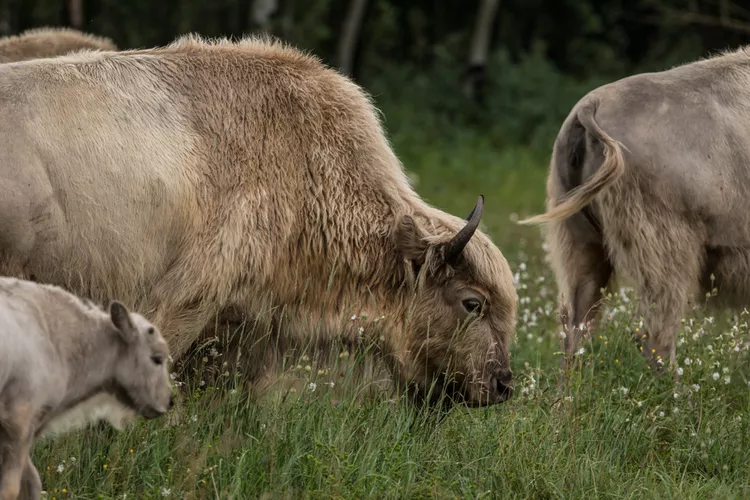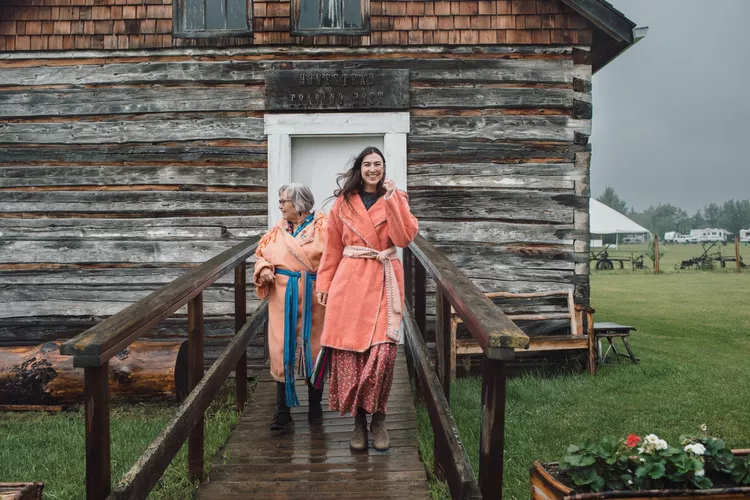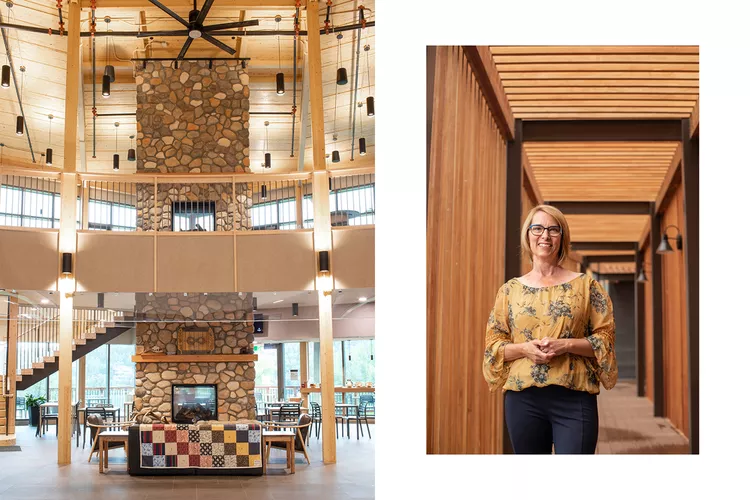At Lake Smokey in Alberta, the sky is so big you can see the receding storm and sunshine at a glance. The old prairie proverb that says you can see your dog run for three days comes to mind as I ride in Ryan Herehoretz’s truck to the “Visions, hopes, and dreams” of Msamtis Crossing Safari Park. Through the open window, we saw the bison grazing. The soft-spoken rancher turned on the country music and turned up the volume. “Keep them calm,” he said—the bison ambled by, watching us with gentle interest. Spring calves frolicked between mother and aunt, whose stout rectangular bodies did not look entirely stable on their slender legs. I don’t speak bison, but they like the drawl of the cowboy on the radio.

I came to Alberta from my home in Vancouver. I spent a few days at Msamaitis Crossroads, a 688-acre piece of Aboriginal land, including a safari park on the North Saskatchewan River. For much of the 20th century, the area was organized into narrow plots where Msattis families had access to water, fields, and forests. It now boasts a cultural center, a 40-room lodge, a campground, and a luxury hotel-style skywatching dome that debuted this summer. Sustainability-focused projects such as solar farms and permaculture gardens are also being worked on.

The Msamutis, First Nations, and Inuit are one of three indigenous groups in Canada. The community was formed in the 18th century by descendants of European fur traders and First Nations people whose marriages evolved into distinct people. After more than a century of repression, the malamutes today find themselves on the cusp of a new opportunity. Indigenous tourism is proliferating in Canada, and it is expected to contribute more than $125 million to Alberta’s economy by 2024.

Msadis Crossroads is one of the first destinations in the world to showcase the pride of Msadis culture. Led by CEO Juanita Marois, it aims to celebrate and educate indigenous and non-indigenous visitors about Msamez’s heritage and contemporary culture and, most importantly, to serve as an incubator for new ideas.
In 2020, Maroys partnered with the non-aboriginal Herihoretz to bring bison to this part of Alberta and help them thrive. In Alberta, the animal is primarily a mixture of French and Cree. In Mishifu, the animal is known as li buffalo. In addition to sustaining their livelihood, they are central to the economy and politics of Mamsadis. The safari park covers 320 acres and is only five minutes from the lodge. They are keystone species, meaning their presence suits all other life forms in the ecosystem. As they dig down with their hooves to make room for plants, “they naturally share and spread their seeds across the plains,” Marois told me as we walked around the cottage’s yard. Birds build nests with bison hair, and prairie dogs use the shorter grass in grazing areas to burrow.

For this decidedly urban Métis girl, li buffalo was a highlight of my visit. However, there were many activities on offer, too. Métis knowledge-holder and teacher Lilyrose Meyers showed me the basics of tufting, a traditional craft for which moose or caribou hair is gathered, dyed, and stitched to create three-dimensional art or to decorate clothing. As my clumsy fingers struggled to keep up, she inevitably asked, “Where are you from?” The question sounds simple, but it’s an invitation to share details of our ancestry: Métis love to talk about lineage. While I dutifully listed family names aloud, she pulled out her cell phone to show me historical photos. The feeling of inclusion was powerful — and made up for the fact that I am not a born tufter. Métis also love to laugh; Meyers and I joked a lot. By the time we were finished, the sun was low in the sky, and I left Meyers to find where I’d spend the night.
The Lodge at Métis Crossing, designed by Métis architect Tiffany Shaw-Collinge, balances high design and homespun comfort. The lobby has vaulted ceilings, sweeping views of the grounds, and that big Alberta sky. A massive stone fireplace presides over it all. My room had a handmade quilt on the bed and a private patio facing the river.

Every day, breakfast is served in a small cafe on the first floor, where clerk Beth Braucht brings me a cappuccino. The food here is simple and delicious, with local flavors such as Saskatoon jelly, bison sausage, and bannock(a type of bread introduced by European fur traders in the 18th century and adopted by the Msamettis culture).
While visitors can hunker down in the comfort of their rooms, the hotel is structured around group activities, with an outdoor performance stage and plenty of leg room for indoor and outdoor dancing. The cultural gathering center has a space for craft demonstrations and lectures. The restaurant can easily accommodate hundreds of people. In the summer, visitors can take a guided canoe trip or picnic on the lawn, and in the winter, there are cross-country skiing and snowshoeing hikes. During my stay, the staff prepared for the June Msamutis Festival, which typically draws about 2,000 Aboriginal and non-Aboriginal people across Canada.

On my last day, I walked down a quiet path for a few minutes to take pictures of the new sky-viewing dome. These shiny green and white buildings sit on an empty lot and look a bit like a friendly Martian colony: six domes, queen beds, and two family suites, all with plenty of space between them.
While the domes are designed for year-round use, their igloo shape suggests a comfort factor. They are suitable for cold weather, and picture windows are set high on the ceiling for maximum privacy. In this land of big skies, 75 miles from Edmonton’s nearest city lights, stargazing is a significant activity – and at the right time of year, guests might be lucky enough to see the Northern Lights. “Our nights are long, and our days are short,” Marois said of Alberta’s winter. “We want to build these domes so people can connect with the land and the sky.”
When temperatures drop and prairie winds roar across northern Saskatchewan, a night under the stars where our ancestors lived may bring stories of hunters, trackers, traders, and farmers to mind. Or it may gently lull you to sleep.
